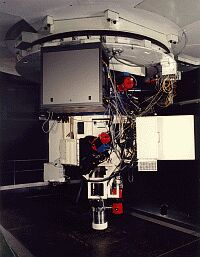 | |||
|
| Home > Public Information > WHT Public Information > Instruments > FOS |
Faint Object Spectrograph (FOS-2)

First light: October 1987
De-commissioned: Jan 1998.
Designed and built by: Durham University and Royal Greenwich
Observatory.
Description: The FOS is a collimator-less dedicated
(not versatile) spectrograph designed to have the utmost efficiency for
use at low dispersion and covering the widest possible wavelength range.
It employs a transmission grating whose substrate is cemented onto a cross-dispersing
prism which in turn is cemented onto the aspheric plate of a Schmidt-type
camera, so eliminating four glass-air surfaces. The grating lies in the
divergent beam from the ISIS slit assembly when the straight-through mode
is selected. The resultant complicated aberrations are satisfactorily corrected
by appropiate adjustments in the separation, tilt and centering of the
rest of the components of the system. A CCD detector is mounted on a cooled
finger which supports it at the internal focus of the Schmidt-type camera
so avoiding the need for a further reflecting surface to provide an external
focus as for the ISIS cameras. A similar spectrograph, built jointly by
the RGO and Durham University, is operating on the Isaac Newton Telescope.
The troughput of the optical system is similar to that of the INT FOS,
that is about 70% at the peak of the grating blaze.
Some scientific highlights:
More photos of this instrument: http://www.ing.iac.es/PR/archive/wht/instruments.html
|
| Top | Back |
|

